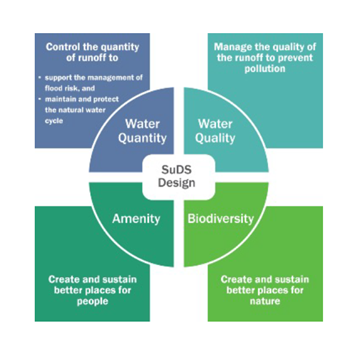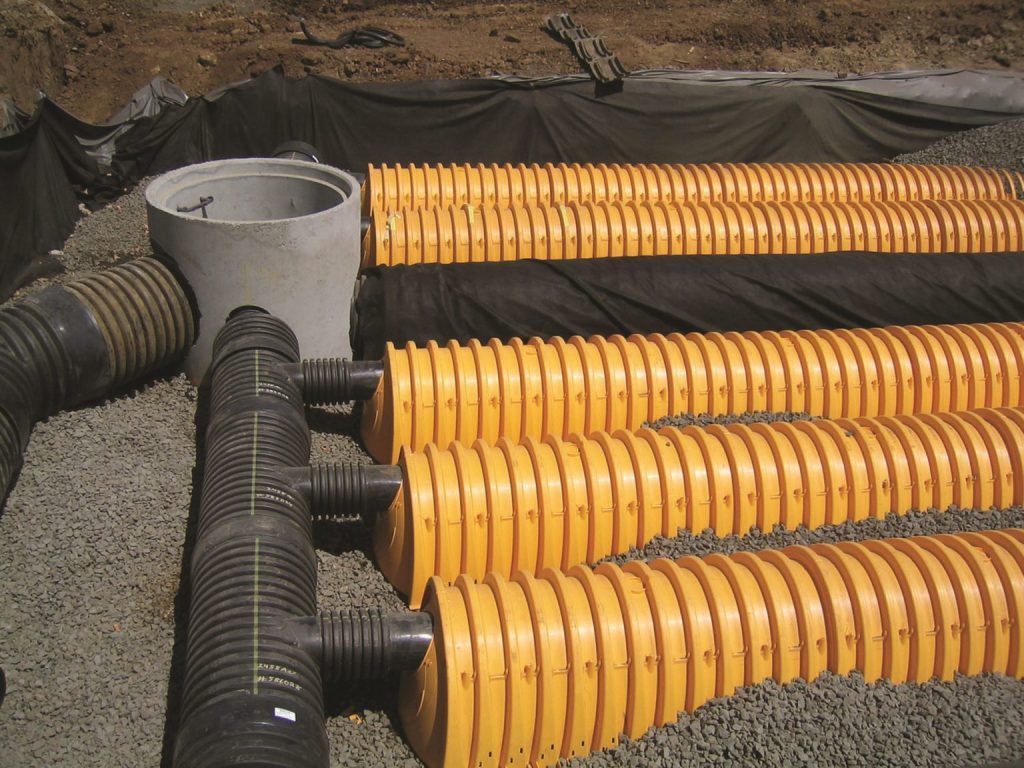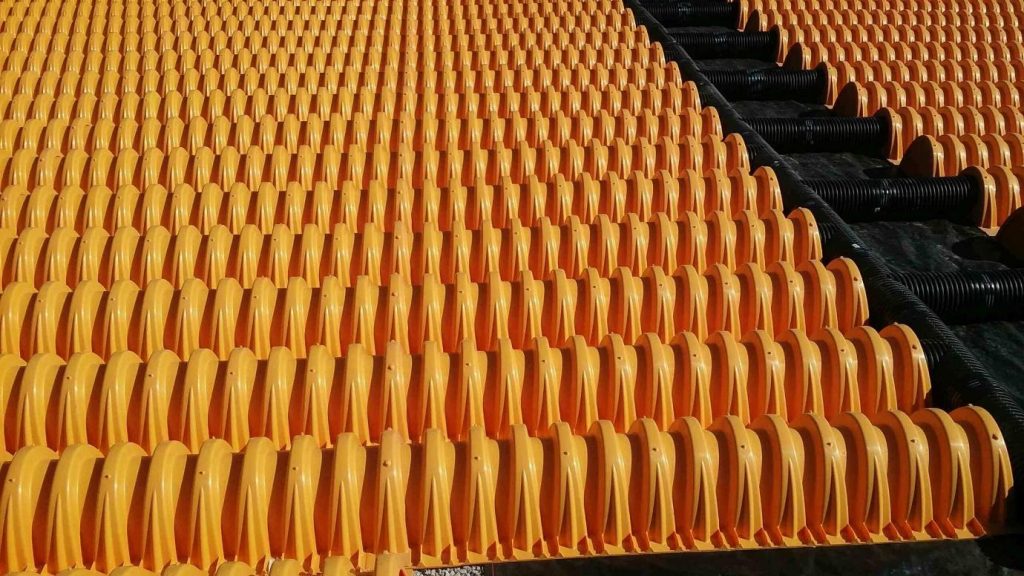Traditionally, the predominant approach to management of storm water runoff in the UK has been through engineered sewer-based systems that would now be classed as ‘Grey Infrastructure’. In the brave new world of sustainable drainage systems, SuDS attenuation systems that are still generally considered as grey infrastructure typically collect rainfall from impervious surfaces, such as road-ways, hard standings and rooftops, and then store and discharge it below the ground via a series of crates, pipes or arches through infiltration, or into a local water body via a sewer or surface channel at a controlled flow rate.

CIRIA, however, has long-suggested ‘Green Infrastructure’ (GI) as a preferred SuDS solution to effectively manage the impacts of climate change, growing flood risk and policy changes and legislation that place an emphasis on water quality, as well as effective management. GI is defined as “a strategically planned and delivered network of natural and man-made green (land) and blue (water) spaces that sustain natural processes.” The application of GI is recognised in government policy and advocated by bodies such as the Landscape Institute.
Thus, GI is a complementary, alternative stormwater solution, promoting the idea of natural flood management. GI mimics natural hydrology and seeks to
improve water quality and reduce water quantity by capturing runoff as close to the source as possible and infiltrating, filtering, and storing it for re-use. SuDS practitioners often regard GI using vegetative, surface-based solutions as Best Practice. The methods include diversion ponds, wetlands, detention basins, filter strips, grass channels and swales.

The “Four Pillars of SuDS Best Practice” is a recognised model that illustrates the potential for a SuDS system to provide (1) Management of Water Quantity (i.e. mitigation against flooding); (2) Management of Water Quality (i.e. mitigation against pollution); (3) Biodiversity (i.e. attracting wildlife); (4) Amenity (i.e. providing useful space for activities). When below ground attenuation systems are used within a SuDS scheme, it is unlikely that the biodiversity pillar can be satisfied without the combined use of vegetative SuDS components. In terms of amenity, interpretation of this pillar may be rather ambiguous. Some say that the intention is to create blue/green, landscaped open spaces that can enhance the environment and a sense of wellbeing within the community. Others would argue that functional usefulness is no less an amenity, often driven by developers seeking to maximise land usage, such as a car park built over a below ground attenuation system. In terms of the water quality pillar, many below ground attenuation systems provide no water quality treatment and rely on other parts of the SuDS Management Train to remove pollutants from surface water runoff.

Sometimes the hydraulic load, geographic demands or project requirements mean that a GI system is not able to meet the required performance parameters. In these situations, pipes, crates and chambers can be an integral part of a GI project, providing additional scope for enhanced performance or the resolution of technical constraints. For example, where the infiltration capacity of the ground is poor and a downstream connection to a sewer or water body is not practicable, the additional storage capacity provided by a system installed below the surface-based SuDS feature, can be used to retain a larger volume of stormwater, and enable infiltration at a slower rate.
Whilst some systems can help with the storage and movement of surface water, they cannot address water quality unless part of a treatment train. Water quality management can be achieved through an appropriate combination of vegetative SuDS components and/or proprietary manufactured treatment devices. For example, with its unique Isolator Row in-built water treatment device providing two treatment stages, plus a further two treatment stages provided within the embedment stone, a system like ADS StormTech can also be used in combination with vegetative SuDS installations to enhance both the water storage capacity and pollutant removal performance.
Below ground systems with treatment devices can therefore be used in a variety of GI applications. Pervious surfaces, for example, allow the movement of water through the soil and a below ground storage and attenuation system can be installed underneath.
Downpipes directing stormwater from the roof of a building can also form an integral part of a GI system, helping to replenish groundwater in a controlled manner, whilst filtering out sediments and nutrients from the water to decrease pollutant loads. These systems can also be used as part of a sealed tank system providing rainwater harvesting.
An excellent example GI in the broader context of rainwater harvesting and water management is the recently opened 4.5-acreFrancisco Park, where the old San Francisco Reservoir was transformed into a sustainable and cost effective community space with a stormwater capture and reuse system that will perpetually provide water for the park’s irrigation and toilets, all while helping manage stormwater and preserving the natural flora and fauna.

The stormwater is stored in a 1.9M litre cistern at the top of the hill before being transferred to the service building, where it flows through a series of filtration and disinfecting processes. This includes three StormTech Isolator Rows which capture the “first flush” and trap sediment and other pollutants coming from stormwater runoff. This approach ensured that the water met public health regulations, while saving 5.7M litres of potable water every year.
Three hundred and seventy-two StormTech chambers were installed in a 35m x 45m area of the existing reservoir and then covered with soil. This gave a total storage capacity of 2,000m3
of water in a 1,682m2 footprint. StormTech chambers were chosen because of their ratio of storage volume to footprint area. “There are competing products on the market,” explains Sherwood Design Engineers (SanFrancisco) principal Cody Anderson, and StormTech was chosen as “We needed to store as much water as possible in the given area. We work on projects around the globe with an emphasis on sustainable development and we’re known for having the vision and the technical capacity. The Francisco Park is one of those projects of a lifetime. It’s reclaiming an area in the city of San Francisco that is now a beautiful park for the people.”

Stuart Crisp is UK Manager for Advanced Drainage Systems (ADS). ADS is America’s largest manufacturer of thermoplastic corrugated drainage pipes and a specialist in water management systems. StormTech has a long and successful track record with over 40,000 below ground SuDS attenuation system installations using in excess of 2.5m units.
Originally published in Water magazine August 2022